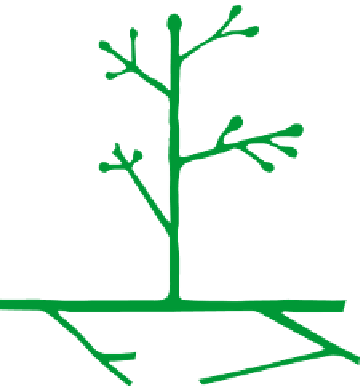Agriculture Reference
In-Depth Information
Introduction
The damp climate of Britain and Ireland favours a
range of diseases. The great variety of garden plants
and crop species leads to further opportunities. This
chapter presents a range of these damaging problems,
highlights life-cycle details that explain their success
and gives a range of control measures available to
the gardener. The distinct but sometimes confusing
area of 'plant disorders' is covered at the end of the
chapter.
A brief review of fungi, bacteria and viruses is
followed by a description of some of the most
important garden disease problems.
Structure and biology of fungi, bacteria and viruses
Fungi, commonly called moulds, cause serious
losses in all areas of horticulture. Some details of
their classification are given in Chapter 4.
A fungus is composed, in most species, of
microscopic strands (hyphae), which may occur
together in a loose structure (mycelium), form
dense resting bodies (sclerotia, see Figure 19.3) or
produce complex underground root-like strands
(rhizomorphs, see Figure 19.15). The group of
organisms causing such diseases as damping
off (
Pythium
), potato blight (
Phytophthora
) and
downy mildew (
Peronospora
) have recently been
re-classified as a separate group called fungus-
like 'Oomycetes', distinct from true fungi. Also,
the organism causing club root (
Plasmodiophora
)
Cytoplasm
Cell wall
Mucilage
Flagella
BACTERIUM
(
Pseudomonas
species)
(
25 000)
Protein protective
layer
Nucleic acid
core
VIRUS
(tomato mosaic virus particle)(
100 000)
Spores
Fusarium
species
(
1000)
Mycelium
Spore-bearing hyphae
(sporangium) of
Botrytis
species
(
400)
Mycelium
A
FUNGUS
SCLEROTIUM CUT THROUGH
TO SHOW DENSE MYCELIUM (
25)
THE SPORE-PRODUCING STRUCTURE OF A
FUNGUS
Figure 19.2
Microscopic structure of fungi, bacteria, and viruses

































